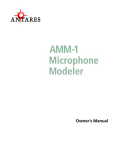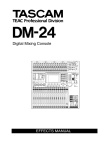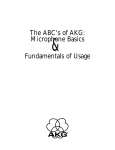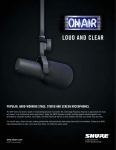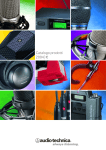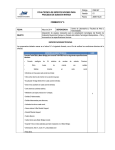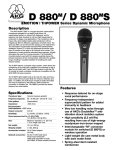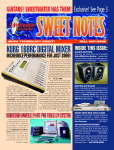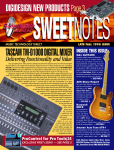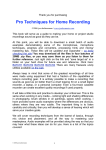Download Antares AMM-1 User`s manual
Transcript
©2000 Antares Audio Technologies. All rights reserved. All trademarks are the property of their respective owners. All names of microphone manufacturers and microphone model designations appearing in this manual are used solely to identify the microphones analysed in the development of our digital models and do not in any way imply any association with or endorsement by any of the named manufacturers. Antares Audio Technologies 464 Monterey Avenue, 2nd Floor Los Gatos, California 95030 USA voice: (888) 332-2636 email: [email protected] web: www.antarestech.com Printed in USA Rev 1.5-02/2000 The Obligatory Legal Mumbo-Jumbo The Antares Microphone Modeler software and this User’s Manual are protected by copyright law. Making copies, adaptations, or derivative works without the prior written authorization of Antares Audio Technologies, is prohibited by law and constitutes a punishable violation of the law. Antares Audio Technologies retains all ownership rights to the Microphone Modeler software and other software offered by Antares Audio Technologies and their documentation. Use of the Antares Microphone Modeler is limited by the following license agreement. Please carefully read all the terms and conditions of this license agreement. At the time of installation of the Antares Microphone Modeler software you will be presented with a copy of the agreement and asked whether or not you agree to it. Continuing with the installation process beyond that point constitutes such agreement. Antares Microphone Modeler License Agreement Antares Audio Technologies grants you a non-transferable, non-exclusive license to use the Antares Microphone Modeler under the terms and conditions stated in this agreement. Use of Antares Microphone Modeler indicates your agreement to the following terms and conditions. License You may: 1. Use Antares Microphone Modeler on only one computer at a time; 2. Physically transfer the program from one computer to another, provided that the program is used on only one computer at a time. You may not: 1. Make copies of Antares Microphone Modeler or of the user manual in whole or in part except as expressly provided for in this agreement. Your right to copy Antares Microphone Modeler and the user manual is limited by copyright law. Making copies, verbal or media translations, adaptations, derivative works, or telecommunication data transmission of Antares Microphone Modeler without prior written authorization of Antares Audio Technologies, is prohibited by law and constitutes a punishable violation of the law. 2. Make alteration or modifications to Antares Microphone Modeler (or any copy) or disassemble or de-compile Antares Microphone Modeler (or any copy), or attempt to discover the source code of Antares Microphone Modeler. 3. Sub-license, lease, lend, rent, or grant other rights in all or any portion of Antares Microphone Modeler (or any copy) to others. Term of the Agreement This agreement is effective until terminated by you or Antares Audio Technologies. You may terminate the agreement at any time by notifying Antares Audio Technologies and destroying all copies of the manual, and erasing Antares Microphone Modeler from all machine-readable media, whether on-line or on archival copies. In the event of breach of any of the terms of this agreement, you shall pay the attorney’s fees of Antares Audio Technologies that are reasonably necessary to enforce the agreement plus resulting damages. Limited Warranty and Disclaimer ANTARES MICROPHONE MODELER AND ACCOMPANYING MATERIALS ARE PROVIDED “AS IS” WITHOUT WARRANTY OF ANY KIND, EITHER EXPRESS OR IMPLIED, INCLUDING, BUT NOT LIMITED TO, THE IMPLIED WARRANTIES OF MERCHANTABILITY AND FITNESS FOR A PARTICULAR PURPOSE. Antares Audio Technologies does not warrant that the functions contained in the program will meet your requirements. The entire risk as to the use, quality, and performance of Antares Microphone Modeler is with you. Antares Audio Technologies warrants the media on which the program is furnished to be free from defects in materials and workmanship under normal use for a period of ninety (90) days from the day of delivery to you as evidenced by a copy of your receipt. Antares Audio Technologies’ entire liability and your exclusive remedy as to the media will be the replacement of the media. SOME JURISDICTIONS DO NOT ALLOW LIMITATIONS ON HOW LONG AN IMPLIED WARRANTY LASTS, SO THE ABOVE LIMITATION MAY NOT APPLY TO YOU. THIS WARRANTY GIVES YOU SPECIFIC LEGAL RIGHTS. YOU MAY ALSO HAVE OTHER RIGHTS WHICH VARY FROM JURISDICTION TO JURISDICTION. Limitation of Liability IN NO EVENT WILL ANTARES BE LIABLE FOR ANY DAMAGES, INCLUDING LOSS OF DATA, LOST PROFITS OR OTHER SPECIAL, INCIDENTAL, CONSEQUENTIAL OR INDIRECT DAMAGES ARISING FROM THE USE OF ANTARES MICROPHONE MODELER OR ACCOMPANYING MATERIALS. THIS LIMITATION WILL APPLY EVEN IF ANTARES OR ITS AUTHORIZED AGENT HAS BEEN ADVISED OF THE POSSIBILITY OF SUCH DAMAGE. YOU ACKNOWLEDGE THAT THE LICENSE FEE REFLECTS THIS ALLOCATION OF RISK. SOME JURISDICTIONS DO NOT ALLOW LIMITATION OR EXCLUSION OF LIABILITY FOR INCIDENTAL OR CONSEQUENTIAL DAMAGES, SO THE ABOVE LIMITATION MAY NOT APPLY TO YOU. Whew! Now that that’s over, let’s get on to the good stuff. Contents Getting Started Chapter 1 Installing AMM Authorizing AMM Technical Support Introducing the Antares Chapter 2 Microphone Modeler Overview About the Technology So What Exactly Does It Do? Operation 8 8 9 10 11 11 Chapter 3 Live or Mixdown Signal Flow Controls Input Section Source Mic Section Modeled Mic Section Preserve Source Tube Saturation Output Level 12 12 13 13 14 17 20 21 22 The Microphone Models Chapter 4 The Mic Model Files Customizing Mic Menus Automation 23 24 24 Realistic Expectations Get Creative Chapter 5 Choice of Input Microphone Microphone Variations Microphone Technique Excessive Frequency Boost Polar Pattern Selection Off-Axis Response Transient Response 26 26 27 27 27 28 28 Chapter 6 30 Appendix 31 Acknowledgments 37 Index 39 Welcome! On behalf of everyone at Antares Audio Technologies, we’d like to offer both our thanks and congratulations on your decision to purchase the Antares Microphone Modeler. Before you proceed any farther, we’d like to strongly encourage you to fill out and return the Microphone Modeler registration card. To make it as easy as possible, we’ve included a sticker with your serial number to attach to the card. The serial number also appears on the bottom of the box, but it’s probably a good idea also to write it in your manual for future reference. As a Microphone Modeler owner, you are entitled to receive notification of any software upgrades, technical support, and advance announcements of upcoming products. But we can’t send you stuff unless we know who and where you are. So please, send that card in. At Antares, we are committed to excellence in quality, customer service, and technological innovation. With your purchase of the Antares Microphone Modeler, you have created a relationship with Antares which we hope will be long and gratifying. Let us know what you think. You can count on us to listen. Again, thanks. The Whole Antares Crew 7 Chapter 1: Getting Started Installing Antares Microphone Modeler Instructions for installing Antares Microphone Modeler for your specific platform are located in the Microphone Modeler Read Me file on the CD ROM. This file may also contain any last-minute Microphone Modeler information that didn’t make it into this manual. Authorizing Antares Microphone Modeler Authorization (the process by which the Microphone Modeler software installed on you computer is allowed to run) is accomplished by a technique called “Challenge/Response.” This is described in detail in the Read Me file, but basically, the first time you launch Microphone Modeler you will be presented with a string of letters (the Challenge) and will be asked to enter another string of letters (the Response). To receive the appropriate Response, you will need to provide us with both proof of purchase and your Challenge string. Here are the options for accomplishing this: Proof of Purchase: • Fax a copy of your warranty card with the serial number sticker attached to (408) 399-0036. This is a preferred option in that you can be certain that it has arrived prior to your requesting your Response. • If you have access to a scanner, scan your warranty card with the serial number sticker attached and send it as a JPEG attachment in the same email as your Response request (see below). • Mail us your warranty card with the serial number sticker attached. You should only rely on this if you don’t have access to either of the other options, as you can never predict when it’s actually going to arrive. (However, you should still mail the warranty card in any case, so that we can have it physically on file.) 8 Challenge String: • Once you have reason to believe that we have received your proof of purchase (or if you’ve attached it as a scan), copy and paste your Challenge string into an email along with your name, the product name (e.g., Microphone Modeler for MAS) and your serial number and send it to: [email protected]. You will receive your Response string by return email, usually within 24 hours (unless you have sent the email over a weekend, in which case you should receive it the following Monday). • If you do not have access to email, fax us your Challenge string along with your proof of purchase as described above. Be sure to include your fax number, We will fax the Response string back to you at that number. When initially installed, Microphone Modeler will run for ten days without authorization, so even if your can’t contact us right away you can still use your software in the meantime. (During this period, click the ”Continue“ button whenever you are presented with the Authorization dialog box.) But don’t procrastinate too long. After those ten days are up, you will no longer be able to launch Microphone Modeler until the correct Response is entered. Technical Support In the unlikely event that you experience a problem using Antares Microphone Modeler, try the following: 1. Make another quick scan through this manual. Who knows? You may have stumbled onto some feature that you didn’t notice the first time through. 2. Check our web page for tips, techniques, or any late-breaking information: www.antarestech.com 3. Call your local Antares dealer. 4. Call us at (888) 332-2636, or (408) 399-0008 Monday through Friday between 9am and 5pm USA Pacific Standard Time. 5. Email us at: [email protected] For options 3, 4 and 5, please be prepared to provide the serial number of your copy of Antares Microphone Modeler. 9 Chapter 2: Introducing the Antares Microphone Modeler Overview If you’ve spent any time lately flipping through the pages of pro audio magazines, you have almost certainly noticed the intense focus on microphones. From the proliferation of exotic new mics to the almost cult-like following of certain historical classics, never has the choice been greater. But amassing a substantial collection of high-end mics is financially prohibitive for all but the most wellheeled studios. Enter the Antares Microphone Modeler. Using our patented Spectral Shaping Tool™ technology, we’ve created precise digital models of a wide variety of microphones, from historical classics to modern exotics, as well as a selection of industry-standard workhorses. Simply tell the Microphone Modeler what microphone you are actually using and what microphone you’d like it to sound like. It’s as simple as that. With the Microphone Modeler, you can afford to record each track through a model of the specific mic that will best produce that ideal sound you’re looking for. Or use it in live performance to get the sound of mics you’d never consider using on stage. You can even use it during mixdown to effectively change the mic on an already recorded track. Not only do the models reproduce all of the subtle sonic characteristics that make each microphone unique, but they also give you control of each mic’s specific options. Does the mic have a low cut filter? If so, it’s in the model. Wind screen on or off? Close or far placement? Each option results in the same sonic effect that it would have with the actual modeled mic. And for that final touch of perfection, you can even add some tasty tube saturation. 10 And with the ability to download new models from our web site, the Microphone Modeler will always keep you at the forefront of the microphone art. About The Technology The models employed by the Microphone Modeler are not derived from theoretical considerations. They are generated by a proprietary analysis process that is applied to each physical mic modeled. Not only the sonic characteristics, but the behavior of other parameters such as low-cut filters or proximity effects accurately reflect the specific performance of each individual microphone we model. The precision of these models allows the Microphone Modeler to reproduce even the subtle (and sometimes not-so-subtle) sonic variations that one often finds in different samples of the same model of microphone. Consequently, for some important mics, we’ve provided multiple models, each based on measurements taken from individual mics. Another advantage of our model-based approach is that there is essentially no processing delay apart from the natural phase effects of the microphones being modeled and any delay inherent in the operation of the host application or hardware environment. Finally, the quality and signal-to-noise characteristics of the processing are pristine. Because of our commitment to model-based processing, there are none of the limitations or distortions characteristic of FFT-based algorithms. The quality of the output is limited only by the quality of the input. So What Exactly Does It Do? While there is a lot of fairly complicated stuff going on under the hood, the essential functionality of the Microphone Modeler is really quite simple. Basically, audio from a microphone is input to the Microphone Modeler where it is first processed by a “Source Model” which serves to neutralize the known characteristics of the input mic. The audio is then processed by a second “Modeled Mic” model which imposes the characteristics of the modeled mic onto the previously neutralized signal. Finally, the audio is passed through a model of a high-quality tube preamp offering the option of classic tube saturation distortion. The details are found in the next chapter. 11 Chapter 3: Operation Live or Mixdown? The Microphone Modeler functions equally well processing audio during its original performance or later during the mixdown process. However, if you have the choice (which you typically will for everything but a live stage performance), we strongly recommend using the Microphone Modeler as an insert effect during mixdown. This will allow you to experiment with mic choice and various mic settings while auditioning their effect in the context of the entire mix. If you do choose to work this way, it is important that you carefully document all mic data for each recorded track. This should include the mic used, any settings such as low-cut filter and/or response pattern selected, as well as the average distance between the mic and the signal source (singer, instrument, etc.). This information will be required to properly set the Source Mic controls during the mix. Signal Flow The Microphone Modeler is divided into a number of discreet functional blocks as follows (in the order of signal flow): Input For setting the input level of the audio to be processed. Source Mic For indicating the mic (and the state of its various parameters) that was actually used to record the audio. Modeled Mic For selecting the mic (and the state of its various parameters) whose sound you would like to model. Tube Saturation For adding a model of analog tube saturation distortion. 12 Controls: Input Section Output For setting the output level of the processed audio. The use of each of the individual controls is covered below. Controls Input Section The Input Gain slider, as is no doubt obvious, is used to set the level of the incoming audio. The exact amount of gain or attenuation is displayed numerically above the slider. In most instances, the input gain should be set at the highest level that does not cause the 0 dB “LED” of the graphic level meter to light. The Level Meter displays the level of the audio as it is being processed by both the Source and Modeled Mic models. Because some models (or combinations of models) can result in increased amplitude at various frequencies, changing to a different mic model or changing a model’s settings may require an adjustment of the Input Gain to avoid clipping. 13 Controls: Source Mic Section In practice, you should start out by setting the Input Gain at a bit under the optimum level. Once you’re confident that you’ve found the right mic settings for your track, you should go back and fine tune the gain for maximum level without clipping. Source Mic Section The SOURCE MIC section is where you specify the mic and the settings that were (or will be) used to capture the input sound. The purpose of these selections is to remove the effect of the source microphone, resulting in the signal that would have been recorded by an ideal instrumentation microphone with no proximity effect. Source Mic Menu The Source Mic pop-up menu is used to select a specific model of mic. In some cases a mic will have a second listing with “(w)” appended to the mic’s name. This indicates that the mic we modeled was supplied with a windscreen and this is the model of the mic with the windscreen attached. If your audio was captured using the windscreen, you should select this version of the model. When you first install the Microphone Modeler, the menu will include all of the mics that we had modeled up to the point at which the CD ROM was released for duplication. You should be sure to check the Antares web site (www.antarestech.com) for new models completed since that release. Additionally, the menu offers a selection called “Bypass.” When Bypass is selected, the source signal is passed unmodified to the Modeled Mic section. You should select Bypass when your source was not recorded with a microphone (e.g., guitar via direct box, direct synth input, etc.). If your desired mic is not listed in the menu (nor available as an additional model on our web site), you can try one of the following (in order of preference): 1) Use a different mic that is listed — this is, of course, only an option if you’ve not yet recorded the audio and do, in fact, have another listed mic. 14 Controls: Source Mic Section 2) Select another mic on the list whose characteristics are known to be similar to your mic (a similar model from the same manufacturer, for example). 3) Select another mic of the same general type as your mic, e.g., dynamic, large diaphragm condenser, etc. 4) Select Bypass from the menu It must be stressed that selecting option 2, 3 or, especially, 4, will compromise the Microphone Modeler’s ability to accurately reproduce the sound of the desired modeled mic. That’s not to say that you won’t be able to get something that sounds great, just that it’s unlikely to be an accurate simulation of whichever mic you chose in the Modeled Mic section. In particular, if you choose Bypass as the Source Mic and any mic as the Modeled Mic, the resulting effect is equivalent to having recorded the audio with the actual physical mic (which you, of course, did) and then having played back that track through a perfect set of speakers and rerecorded it with the Modeled Mic. Again, maybe a great sounding creative effect, but not an accurate representation of the Modeled Mic. Note: If we don’t have a model of your mic and you really, really want to use it as a source mic, you might consider giving us a call and seeing if we’re interested in modeling it. If so, you’d have to be willing to send it to us and have it out of your possession for about 5 working days. Low-Cut Menu If the mic you select in the Source Mic menu is equipped with a userselectable low-cut filter, the Low-Cut pop-up menu will allow you to select from among the actual filter settings available on that mic. (If the selected mic does not have a low-cut filter, the menu will be grayed out.) If the source mic does include a low-cut filter, select the low-cut setting that was (or will be) used when capturing your audio. Note: It is important to keep in mind that the purpose of this setting is to “undo” the effect of any low-cut filter that was used to capture your audio. If you play around with this setting, you may initially think that it’s working “backwards.” That is, changing the menu selection from OFF to any filter setting will actually cause a bass boost in the monitored audio. 15 Controls: Source Mic Section However, once you think about it, you will realize that this is the way it’s supposed to work. The purpose of all the controls in the Source Mic section is to neutralize the effects of the source mic. So, when you select a low-cut filter, you’re telling the Microphone Modeler that the source mic recorded the audio with that much bass attenuation and, therefore, the model must now boost the bass an equal amount to remove the source mic’s sonic coloration. (Trust us, this fried our brains a bit at first, too.) Pattern If the mic you select in the Source Mic menu is equipped with userselectable pick-up patterns (i.e., omni, cardioid, hypercardioid, etc.), the Pattern pop-up menu will allow you to select from the actual pattern settings available on that mic. (If the source mic does not have selectable patterns, the menu will be grayed out.) If the source mic does include multiple patterns, select the pattern that was (or will be) used when capturing your audio. Note: The purpose of the Pattern selection is to neutralize the varying frequency characteristics that result from each of the available pattern settings, with the assumption that the audio was recorded on axis (i.e., from the front of the microphone). Since the Microphone Modeler has no way of knowing the actual placement of the signal source, it does not attempt to simulate off-axis performance. Proximity The Proximity knob in the Source Mic section should be used to set the average distance that separated the mic and the signal source during the recording of the audio. The purpose of this control is to allow the model to remove any Proximity Effect that may have been introduced by the source mic. Note: Proximity Effect is a boost in bass frequencies resulting from placing a directional mic in close proximity to a signal source. The amount of the effect varies from mic to mic, and is inversely proportional to the distance from the mic to the source (i.e., the smaller the distance, the greater the bass boost). Mics operating in omnidirectional mode do not exhibit a proximity effect. Consequently, if the source mic is an omni mic, or the source mic has selectable patterns and omni is chosen, the Proximity control will be disabled. 16 Controls: Modeled Mic Section Note: Like the Low-Cut control described above, the Source Mic Proximity control may initially seem to be working backwards (i.e., setting a shorter distance will result in an audible bass attenuation). Refer to the explanation back up in the Low-Cut section to understand why this is actually how it is supposed to work. Also note that the effect of the Proximity control is unique for each model of microphone. The Microphone Modeler does not use a generalized approximation of proximity effect. Each model reflects the specific physical properties that create the proximity effect for that individual mic. Modeled Mic Section Here’s where the fun really starts. The MODELED MIC section is where you select the mic (and its settings) whose characteristics you want to apply to your audio. Modeled Mic Menu The Modeled Mic pop-up menu is used to select your desired mic. In some cases a mic will have a second listing with “(w)” appended to the mic’s name. This indicates that the mic we modeled was supplied with a windscreen and this is the model of the mic with the windscreen attached. If you wish to simulate the use of the windscreen, you should select this version of the model. When you first install the Microphone Modeler, the menu will include all of the mics that we had modeled up to the point at which the CD ROM was released for duplication. You should be sure to check the Antares web site (www.antarestech.com) for new models completed since that release. Additionally, the menu offers a selection called “Bypass.” When Bypass is selected, no mic model is applied. The net sonic effect of selecting Bypass here depends on the setting of the Source Mic menu: 17 Controls: Modeled Mic Section • If the correct source mic is selected in the Source Mic menu and Bypass is selected in the Modeled Mic menu, the final output of the Microphone Modeler will be stripped of the characteristics of the source mic, resulting in the signal that would have been recorded by an ideal instrumentation microphone with no proximity effect. • If Bypass is selected in the Source Mic menu and Bypass is selected in the Modeled Mic menu, the final output of the Microphone Modeler will be identical to the original input signal (with the exception of any added tube saturation). Low-Cut Menu If the mic you select in the Modeled Mic menu is equipped with a user-selectable low-cut filter, the Low-Cut pop-up menu will allow you to select from among the filter settings available on that mic. (If the selected mic does not have a low-cut filter, the menu will be grayed out.) If the modeled mic does include a low-cut filter, selecting a low-cut setting will reproduce the same effect that selecting that setting would have on the actual modeled mic. Note: The setting labels that appear in the menu are those that appear on the physical mic. In some cases, the label is the cut-off frequency of the low-cut filter as specified by the mic’s manufacturer. However, the Microphone Modeler does not simply apply a generic low-cut filter at the stated frequency, but instead models the actual filter performance of each modeled mic. In other words, a stated cut-off frequency is only as accurate as the filter on the actual mic. Another Note: Although it’s always best to let your ears be your guide, if your audio was recorded with the source mic’s low-cut filter turned on, in most cases it will be best to turn on the modeled mic’s low-cut filter as well. (After all, there was presumably some reason that someone chose to use that filter in the first place.) Pattern If the mic you select in the Modeled Mic menu is equipped with user-selectable pick-up patterns (i.e., omni, cardioid, hypercardioid, etc.), the Pattern pop-up menu will allow you to select from the actual pattern settings available on that mic. (If the modeled mic does not have selectable patterns, the menu will be grayed out.) 18 Controls: Modeled Mic Section If the modeled mic does include multiple patterns, select the pattern whose characteristics produce the effect you desire. Note: The purpose of the Pattern selection is to model the varying frequency characteristics that result from each of the available pattern settings, with the assumption that the audio was recorded on axis (i.e., from the front of the microphone). Since the Microphone Modeler has no way of knowing the actual placement of the signal source, it does not attempt to simulate off-axis performance. Proximity The Proximity knob in the Modeled Mic section can be used to select a desired amount of proximity effect. Note: Proximity Effect is a boost in bass frequencies resulting from placing a directional mic in close proximity to the signal source. The amount of the effect varies from mic to mic, but is generally inversely proportional to the distance from the mic to the source (i.e., the smaller the distance, the greater the bass boost). Using the Proximity knob to set a particular distance will result in the amount of proximity effect that would be produced by the actual modeled mic when placed at that distance from the signal source. The effect of the Proximity control is unique for each model of microphone. The Microphone Modeler does not use a generalized approximation of proximity effect. Each model reflects the specific physical properties that create the individual proximity effect for that mic. Note: A secondary effect of mic-to-source distance is the extent to which environmental ambience is picked up by a mic. For example, as a mic is moved away from the source, the proximity effect decreases, but the amount of “room tone” increases (assuming that you are not in an anechoic chamber). The Microphone Modeler does not model this effect. However, judicious use of the Proximity control in combination with some appropriately programmed reverb will allow you to create the same effect, with the additional bonus of being able to control the exact nature of the room tone. Mics operating in omnidirectional mode do not exhibit a proximity effect. Consequently, if the modeled mic is an omni mic, or the modeled mic has selectable patterns and omni is chosen, the Proximity control will be disabled. 19 Controls: Preserve Source Preserve Source The Preserve Source controls allows you to split your audio into its bass and treble ranges and process each range separately. This lets you create hybrid mics that combine the bass characteristics of one mic and the treble characteristics of another. One of the two mics will be your actual source mic and the other can be selected from any of the available models. Say, for example, that you have a mic whose bass response is great for a particular track, but whose treble response just doesn’t sound right. With this feature you can preserve the bass response of your source mic while replacing its treble characteristics with that of any of the modeled mics. Here’s how it works: 1) Make all the appropriate settings in the Source Mic section. (Do not select Bypass unless you are going for some special effect, as it will defeat the normal function of this feature.) 2) Choose the other mic for your hybrid and make all the appropriate settings in the Modeled Mic section. (Again, do not select Bypass unless you are going for some special effect.) 3) In the Preserve Source section, click on either the Bass or Treble button (its associated “LED” will light) depending on whether you want to preserve the bass or treble characteristics of your source mic. There are four possible states of the two Preserve Source buttons. Here’s what each does ( o = LED lit): 1) Preserve Source: Bass O Treble O With neither button pressed, frequency splitting does not take place and the Microphone Modeler operates in its normal manner according to the settings in the Source and Modeled Mic sections. 2) Preserve Source: Bass o Treble O With the Bass button pressed, the source mic’s bass characteristics are allowed through unchanged while the treble characteristics are neutralized. Then, at the model end, only the model’s treble characteristics are applied to the signal. The net effect is that you get the source mic’s bass characteristics and the modeled mic’s treble characteristics. 20 Controls: Tube Saturation 3) Preserve Source: Bass O Treble o This, as you’ve probably guessed, is the reverse of No. 2. With the Treble button pressed, the source mic’s bass characteristics are neutralized while the treble characteristics are allowed through unchanged. Then, at the model end, only the model’s bass characteristics are applied to the signal. The net effect is that you get the source mic’s treble characteristics and the modeled mic’s bass characteristics 4) Preserve Source: Bass o Treble o With both buttons pressed, both the source’s bass and treble characteristics are allowed through unchanged and no model is applied to either range. This is equivalent to selecting Bypass in both the Source Mic and Modeled Mic menus, with the exception that the Proximity controls for both the source and modeled mics remain active. Tube Saturation The Tube Saturation section is designed to model the distortion that is typical of a high-quality tube pre-amp. When tube pre-amps are operated in their linear range, there is virtually no signal distortion and their audio qualities are essentially identical to solid state pre-amps. However, it commonly occurs that transients exceed the linear voltage range, resulting in distortion. The distortion characteristics of a vacuum tube pre-amp are vastly different from that of solid state amplifiers and are often described as adding a certain “warmth” to a sound (in contrast to what is often described as the “brittleness” of the solid state sound). The amount of tube saturation effect applied to your audio is controlled by the Tube Saturation Drive control in combination with the Input Gain control. The Drive control determines the amplification factor of the modeled tube pre-amp with the numeric display indicating the amplification in dB. At 0 dB , no distortion occurs, even for full amplitude (+1 or -1) signal levels. These levels represent the “rails” of the amplifier. As the Drive is increased, the amplification is increased. Any regions of the signal that increase beyond the rails generate distortion. (But instead of the usual ugly digital clipping, they are distorted the same way the tube pre-amp would distort the sound.) 21 Controls: Output Level Because the maximum drive is limited to +10 dB, using the Tube Saturation model requires the original signal to be at a level greater than -10 dB. If this is not the case, you should adjust the Input Gain control to increase the level of the sound. (Be certain that Input Gain is not increased so much as to cause the 0 dB meter “LED” to light.) It may be necessary to go back and forth between Drive and Input Gain a few times to get exactly the effect you want. Note: If your audio was recorded at an exceptionally low level, it may be that even maximum Input Gain and maximum Drive will still not result in a level high enough to generate distortion. In that case, either re-record your audio at a higher level (if possible) or use your waveform editing program to digitally increase the level (keeping in mind that this may negatively affect the signal quality). If you want to add tube saturation distortion without otherwise affecting your sound, set both the Source Mic and Modeled Mic menus to Bypass. Output Level The Output Level control is used to fine-tune the Microphone Modeler’s output level. This control is strictly an attenuator (i.e., no gain is available). You should always start with it at 0dB (the top of its range) and then reduce level as necessary. It is particularly useful when adding large amounts of tube saturation. 22 Chapter 4: The Microphone Models Your copy of Microphone Modeler comes with a collection of mic models that is automatically installed along with the plug-in application. These mics will appear in the Source Mic and Modeled Mic menus. In addition, we are constantly modeling more mics. Whether new mics that have just come to market, or classics we’ve just managed to get ahold of, you should find an ever-growing collection to download from our website. We’d also appreciate any suggestions you have for specific mics to model. Email your suggestions to us at [email protected] with the words “Mic Suggestion” in the subject line. We can’t guarantee that we’ll be able to include every mic suggested, but if we see certain mics getting a lot of votes we’ll do our best to include them. The Mic Model Files Each mic model consists of two files: the model file, which is named for the modeled mic, and a matching source mic file whose name also includes the name of the modeled mic with the addition of the suffix, “inv”. These model files are found in a folder named “Antares Models.” On Macintosh systems, this folder is located in the Preferences folder inside the System folder. On PC systems, this folder is located inside the same folder as the Microphone Modeler plug-in. The Antares Models folder in turn contains a “Modeled Mics” folder and a “Source Mics” folder. Each folder contains one file for each microphone. This version of Microphone Modeler includes the ability to add one level of sub-folders in the “Source Mics” and “Modeled Mics” folders. This results in easy-to-organize hierarchical menus in the Source Mic and Modeled Mic pop-ups. As you will see, we have used this feature to organize the mic models by manufacturer. However, you are free to change this organization to anything that works well for you. Simply add or rename subfolders as desired and put the appropriate models in each folder. 23 Customizing Mic Menus Note that the model files are not cross-platform compatible. When downloading new models from the Antares web site, be sure to select the files that are intended for your computer. For each new model you download from the Antares web site, you will end up with two files. As is probably obvious, you should place the model mic file in the Modeled Mics folder and the source mic file (the one with the “inv” suffix) in the Source Mics folder. Customizing the Source and Model Mic Menus The Source Mic and Modeled Mic menus will always reflect the subfolders and model files in their respective folders. Adding a new file or sub-folder to either folder will cause that sub-folder or model to become available in the appropriate menu. Here are a few hints for managing your mic menus: • It is not necessary to have the same mic models in each folder. You could, for example, put only the source model files for the mics you actually own at the top level of the Source Mic folder, eliminating the need to constantly hunt in sub-folders for the few you usually use. • For quick access to a few specific mics on a particular project, create two temporary sub-folders named Project Source Mics and Project Modeled Mics and put all the mics you plan to use for that particular project in them. When you finish your project, just move all the models back into their respective folders. • The mic names that appear in the menus reflect the names of the model files. We have assumed that the actual mic names are probably the most informative. However, if you’d prefer something else, you can change the names of the model files and those new names will appear in the menus. If you choose to do this, we strongly recommend that you give both the source and model files the same name and keep the “inv” suffix for the source file. (The Microphone Modeler will automatically strip the “inv” from the end of the name when displaying it in the Source Mic menu. However, if you accidentally (or purposely) put a source mic file in the Modeled Mic folder, the “inv” will appear as part of the name in the Modeled Mic menu.) 24 Automation Automation and the Mic Menus Many host applications provide the ability to automate the settings of plug-ins. Although the Microphone Modeler is totally automatable, you should be aware that the fact that you can add and delete items from the Source Mic and Modeled Mic menus can result in problems with some automation systems. To understand why, it’s important to note that host applications typically remember menu selections not by storing the actual item selected, but by storing its position in the menu. Imagine, for example, that you select a mic that is the 17th mic listed in the menu and store that setting for later recall via automation. In the meantime, you check our website and download some new models, two of which end up in the list above that formerly 17th mic. Your originally chosen mic is now 19th in the menu and the next time you recall that automation setting, instead of getting the mic you expect, you’ll get the mic that is now in the 17th position. Unfortunately, there is no easy way around this. Simply be aware of it and be prepared to update your automation settings if you add mics to the menu. 25 Chapter 5: Realistic Expectations (or, Microphone Modeler Meets the Space-Time Continuum) Although the Microphone Modeler seems in many ways to be almost magic, it is, in fact, simply very clever science. And as such, it remains subject to those pesky laws of physics. To get the maximum satisfaction out of the Microphone Modeler, it is important to have realistic expectations of exactly what it can and can’t do. (Most of what it can’t do relates to the physical impossibility of recovering information that wasn’t in the original signal to begin with.) Here are the main issues to be aware of: • Choice of Input Microphone Luckily for all of us, the general quality of “affordable” microphones has reached a remarkably high level. Consequently, if you stick with well-known manufacturers, most any reasonable quality mic will provide sufficient performance to allow the Microphone Modeler to do its magic. (OK, we said it wasn’t magic, but we’re speaking metaphorically here.) On the other hand, you can’t expect to go into a large (but unnamed) mass merchandiser of low-cost electronics gear and pick up a $19.95 mic and expect the Microphone Modeler to make it sound like a U87. If a source mic has massive roll-off in a particular frequency range, there is no way the Microphone Modeler can produce the signal that would have been captured had the source mic had better response. • Microphone Variations While there are obviously major differences between various models of microphones, there are also often more subtle differences between different samples of the same model of microphone. Whether due to manufacturing variances, age or condition, there is no guarantee that the mic we modeled will be identical to your source mic or to a specific mic you want to model. In the case of some well-known classics, we have even provided multiple models of the same (but sonically differing) mic from different sources. 26 Realistic Expectations • Microphone Technique In getting the best possible recorded sound, mic technique and placement are at least as important as mic choice (if not more so). A good engineer can record a great track with an SM57 while a poor one can make a U47 sound like doo doo. If your audio is not well-recorded in the first place, the Microphone Modeler can to do very little to improve it. If you start with a poorly recorded track, all the Microphone Modeler will do is make it sound like a track that was poorly recorded with a great mic. • Excessive Frequency Boost Although the Microphone Modeler’s processing does not itself add noise to your signal, any noise in your original audio or noise added by intervening processes (e.g., A/D conversion, pre-Microphone Modeler dynamics processing, etc.) will be accentuated by any large amount of frequency boost. This should only be a problem when your source mic has a substantial bass or treble roll-off and the modeled mic has a corresponding boost or, more likely, when your audio was recorded with a low-cut filter on the source mic and you do not use a low-cut on the modeled mic. In both of these cases, the models will apply substantial gain to the affected frequency ranges, raising the level of added noise along with the desired signal. If the resulting noise level is unacceptable, you should choose a different combination of mics and/or turn on the modeled mic’s low-cut filter. • Polar Pattern Selection The Microphone Modeler can’t recover information that was not recorded as part of the original signal. For example, if the original audio was recorded with a highly directional pattern (hence picking up little room tone), you can’t set the modeled mic to Omni and expect the room tone that would have been recorded if the original was set to Omni suddenly to appear. You can however, simulate that effect with some judicious use of reverb or an environmental simulator. Conversely, if your source was recorded with an omni mic and it picked up some unwanted audio from the rear, you can’t realistically expect to set the modeled mic to hypercardioid and have the unwanted audio disappear. • Off-Axis Response The purpose of the Pattern selection is to model the varying frequency characteristics that result from each of the available pattern settings, with the assumption that the audio was recorded on axis (i.e., from the front of the microphone). Since the Microphone Modeler has no way of knowing the actual placement of the signal source, it does not attempt to model off-axis performance. 27 Realistic Expectations • Transient Response One of the key characteristics of various types of microphones is their transient response (i.e., the way that their diaphragms respond to extremely rapid amplitude fluctuations, typically during a sound’s attack phase). Intuition would suggest that modeling changes in transient response between mics would be next to impossible — particularly changing a source mic with a slow response to a modeled mic with a fast response. Amazingly, that turns out not to be the case. The Microphone Modeler’s models do model variations in transient response in both directions. Rather than explain how this is done (which we are disinclined to do, anyway), we suggest that you demonstrate it to yourself with the following experiment: 1. In your waveform editor, use the Pencil Tool (or equivalent waveform drawing tool) to create a single high-amplitude spike. 2. Process this file through the Microphone Modeler with the Source Mic set to Bypass (so the spike is passed through the Source section unchanged) and the Modeled Mic set to the ATM31. 3. Examine the processed signal in the waveform editor. You should see obvious evidence of the smeared transient. 28 Realistic Expectations 4. Now take that processed file (which is now a model of the spike as it would have been recorded by the ATM31) and send it through the Microphone Modeler again, this time with the Source Mic set to the ATM31, and the Modeled Mic section set to Bypass. If that Source Mic model is doing its job, it should actually remove the characteristics of the ATM31, including that smeared transient. 5. Once again, examine the processed signal. The evidence of transient smearing will be gone and the spike restored to its former spikey self. (Frankly, the first time we tried it, we could hardly believe it ourselves. Thanks, Dr. Andy.) 29 Chapter 6: Get Creative Up to this point, all of the instructions in this manual have focused on how to use the Microphone Modeler for its primary purpose: making one mic sound as accurately as possible like another. But don’t let that limit you. We’ve purposely given the controls wide ranges to allow you to move beyond what might be considered useful for strict modeling. Try some of the following: • Select a Source Mic that doesn’t match your physical mic. In fact, try one whose characteristics are as different as possible from your physical mic. • Select Bypass in the Source Mic menu to combine the sound of your physical mic with the sound of the modeled mic. • Create a “Hyper” version of one of your source mics. To do this, select Bypass in the Source Mic menu (to pass through the sound of your mic unmodified) and then select your source mic in the Modeled Mic menu. The result will be to accentuate all of the characteristics that give your source mic its unique character, making it sound like itself, only more so. • Swap some model files between the Source and Model folders (i.e., put the source file in the Modeled Mic folder and vice versa). This is likely to result in some strange timbres, but sometimes strange is good. • Extreme Proximity settings can give strange, but interesting effects. Try wildly differing settings in the Source and Model sections. • Dynamically change Proximity settings during a performance. • Overdrive the Tube Saturation section for some serious gruzz. None of the above are likely to give you the sound of any mic that exists in nature, but they can definitely give your recordings unique and striking timbres. 30 Appendix Listed below are all of the mics that we have modeled as of the date this manual went to press. (Be sure to check the Antares web site frequently for additional models.) Please Note: All trademarks appearing below are the property of their respective owners. The following manufacturer names and model designations are used solely to identify the microphones analyzed in the development of our digital models and do not in any way imply any association with or endorsement by any of the named manufacturers AKG C12A Large Diaphragm Condenser A classic multipurpose studio mic (this one dates from the late 60s) C414 C414B/ULS Limited Edition Gold C414B/ULS Modified by Audio Upgrades (mod1) C414B/ULS Modified by Jim Williams (mod2) Large Diaphragm Condenser Multipurpose studio mic 460B/CK61-ULS Small Diaphragm Condenser Precise, neutral recording mic D112 Large Diaphragm Dynamic Classic kick drum and bass guitar mic D 790 Large Diaphragm Dynamic Hand-held vocal C1000S Small Diaphragm Condenser With a battery power option, often used for field recording C 3000 Large Diaphragm Condenser General purpose C 4000 B Dual-Diaphragm Condenser Solid state version of the SolidTube, general purpose 31 Alesis AM61 Audio Engineering Associates R44C Audio-Technica ATM11 ATM31 AT853Rx AT3525 AT4047/SV AT4033a/SM AT4050 AT4055 AT4060 Audix D4 OM2 OM3-xb OM5 Large Diaphragm Condenser w/tube circuitry A rich warm sound ideal for vocals and instruments Large Diaphragm Boundary - Ribbon Replica of the classic RCA 44 ribbon mic Dynamic Drums Small Diaphragm Condenser General purpose Electret Condenser Hanging choir mic Large Diaphragm Condenser Vocals and general purpose Large Diaphragm Condenser Recreates the sound of vintage F.E.T. condenser mics Large Diaphragm Condenser General purpose, drum overheads Large Diaphragm Condenser General purpose Large Diaphragm Condenser Live vocal mic Large Diaphragm Condenser - Tube Circuitry Vocals and general purpose Dynamic Kick drum, acoustic bass, piano, sax Dynamic Hand held vocal Dynamic General purpose Dynamic Vocals Please Note: All trademarks appearing above are the property of their respective owners. The manufacturer names and model designations are used solely to identify the microphones analyzed in the development of our digital models and do not in any way imply any association with or endorsement by any of the named manufacturers. 32 B&K beyerdynamic Brauner CAD Coles Earthworks ElectroVoice Groove Tubes 4007 Large Diaphragm Prepolarized Condenser Close-micing drums, percussion, brass M-500 Limited Edition Classic (Silver) Large Diaphragm Condenser Vocal, instruments MC-834 Large Diaphragm Condenser Vocals , piano, strings, brass, voice-overs VM1 Large Diaphragm Tube Condenser w/Class A amp Reference recording Equitek E100 Condenser Vocal, instrument, drum overheads Equitek E200 Condenser Vocal, orchestra, acoustic guitar, kick drum Equitek E350 Servo Condenser Vocal, piano, overhead, acoustic guitar, amps C400S Large Diaphragm Condenser General Studio VSM1 Single Valve Condenser Vocal, strings, guitar 95Ni Dynamic Vocal, instrument amps 4038 Large Diaphragm Boundary - Ribbon Sax, horns, piano, guitar Z30x Enhanced Cardioid Condenser Vocal, guitar, drums, general purpose TC30K Omni Condenser Drums, guitar, bass PL20 Mid Diaphragm Dynamic Early predecessor to the RE20 - Bass, drums, vocals, electric guitar N/D357 Mid Diaphragm Dynamic Frequency expressly contoured for female vocals MD-1 Large Diaphragm Tube Condenser Studio vocal, general purpose Please Note: All trademarks appearing above are the property of their respective owners. The manufacturer names and model designations are used solely to identify the microphones analyzed in the development of our digital models and do not in any way imply any association with or endorsement by any of the named manufacturers. 33 Lawson L47MP Manley Labs Reference Gold MicroTech Gefell UMT 800 Neumann U 47 Oktava RCA Rode 34 Large Diaphragm Tube Condenser Vocals, acoustic guitar, strings, piano, choir, orchestra, sax Large Diaphragm Tube Condenser Ultra high quality recording Large Diaphragm Condenser Close-miced vocals, horns, ensembles Large Diaphragm Tube Condenser A classic vocal mic. Sinatra’s first choice. U 87 U 87 70th Anniversary Gold Edition Large Diaphragm Condenser Vocals, piano, acoustic bass, drums, acoustic guitar M 149 Large Diaphragm Tube Condenser “The best mic I have EVER used.” ~Chuck Surack (Thanks Chuck!) TLM 103 Large Diaphragm Condenser Vocals, acoustic guitar, horns, piano TLM 193 Large Diaphragm Condenser Vocals, acoustic guitar, drum overheads, strings, sax KM 184 Small Diaphragm Condenser Acoustic guitar, drum overheads, hi hat, strings, percussion, piano MC-012 Small Diaphragm Condenser General purpose instruments and live performance MK-319 Large Diaphragm Condenser Vocal, general purpose BK5A Uniaxial Ribbon Vocal, general purpose NT1 Large Diaphragm Condenser Vocals, instruments NT2 Large Diaphragm Condenser Vocals, acoustic guitar, winds, piano NTV Large Diaphragm Tube Condenser Vocal, general studio Please Note: All trademarks appearing above are the property of their respective owners. The manufacturer names and model designations are used solely to identify the microphones analyzed in the development of our digital models and do not in any way imply any association with or endorsement by any of the named manufacturers. Royer R-121 Sennheiser MD421 MD441 E609 E835S Shure Beta 52 Beta 57A Beta 87A Beta 98D/S SM7A SM57 SM58 Shure SM81 SM98A KSM32 VP88 Ribbon Electric guitar, overhead drums, orchestral, choral, room micing Large Diaphragm Dynamic Drums, vocals guitar, amps Large Diaphragm Dynamic Designed to simulate the sound of a condenser mic for vocal, sax Large Diaphragm Dynamic Live performance guitar amp and drum mic Large Diaphragm Dynamic Live performance vocal Large Diaphragm Dynamic Kick drum, bass amp, acoustic bass Large Diaphragm Dynamic Drums, guitar amplifiers, brass, woodwinds, vocals. Large Diaphragm Condenser Vocals, live performance Mini Condenser Toms, snares, percussion Dynamic Vocals, bass amp Large Diaphragm Dynamic Guitar, guitar amp, drums Large Diaphragm Dynamic Vocals, general purpose Large Diaphragm Condenser Guitar, cymbals, strings, vocals, piano Large Diaphragm Condenser Drums, brass, winds Large Diaphragm Condenser Vocals, acoustic guitar, winds, ensembles, and drum overheads. Large Diaphragm Condenser - Single Point Stereo Modeled in MS (mono simulation) mode Please Note: All trademarks appearing above are the property of their respective owners. The manufacturer names and model designations are used solely to identify the microphones analyzed in the development of our digital models and do not in any way imply any association with or endorsement by any of the named manufacturers. 35 Sony C800G C37P C48 Telefunken U-47 Large Diaphragm Tube Condenser Vocals: studio and post-production Tube Condenser General purpose Large Diaphragm FET Condenser Vocals, guitar Large Diaphragm Tube Condenser An extremely rare vintage version of the U-47 from the days when Telefunken distributed mics for Neumann. This sample is still equipped with the original tube. Please Note: All trademarks appearing above are the property of their respective owners. The manufacturer names and model designations are used solely to identify the microphones analyzed in the development of our digital models and do not in any way imply any association with or endorsement by any of the named manufacturers. 36 Acknowledgments As you might imagine, sourcing and modeling all of those mics was (and remains) an interesting logistical challenge. Luckily for us, we have had assistance from a variety of interested dealers, manufacturers, studios and individuals who were all willing to let us subject their precious microphones to our arcane modeling ritual. Thanks to all those listed below: Rob Actis Actis Company, San Diego, CA Audio Engineering Associates Pasadena, CA Audix Corporation Wilsonville, OR Demien Bannister Bananas at Large, San Rafael, CA jeramy bassermann Opus Nine, El Granada, CA Robert Berry soundtek studios, Campbell, CA Ken Capitanich Mars Studios, Aptos, CA Eric Chun Creative Music Services, Auburn, CA Cutting Edge Audio San Francisco, CA Guitar Showcase San Jose, CA Stephen Jarvis San Francisco, CA Manley Laboratories Chino, CA National Sound Engineering Norcross, GA Glen Peiser Guitar Center San Jose Santa Cruz Sound Company Santa Cruz, CA Paul Savasta Odyssey Pro Sound, Salem, MA Skip’s Music Sacramento, CA David Staats Castro Valley, CA Studio Tech Supply Dallas, TX Chuck Surack Sweetwater Sound, Ft. Wayne, IN Trakworx San Francisco, CA Wind Over the Earth Boulder, CO And, of course, our own Michael “Mr. Microphone” Logue and mic tester extraordinaire Kelly Montgomery. 37 38 Index Symbols F “(w)” 14, 17 Frequency boost, excessive 27 A I About the technology 11 Acknowledgments 37 Antares Audio Technologies contacting 9 Antares Microphone Modeler about the technology 11 authorizing 8 controls 13 installing 8 overview 10 what it does 11 Authorizing Antares Microphone Modeler 8 Automation and the Mic Menus 25 Input 12 Input Gain 13 Input Microphone, choice of 26 Installing Antares Microphone Modeler 8 “inv” 23 B Bypass 14, 15, 17, 18, 29, 30 C Challenge String 9 “Challenge/Response” 8 Controls 13 Input Section 13 Modeled Mic Section 17 Output Level 22 Preserve Source 20 Source Mic Section 14 Tube Saturation 21 Creative techniques 30 Customizing the Source and Model Mic Menus 24 L Level Meter 13 Live or Mixdown? 12 Low-Cut Menu 15, 17 M Managing mic menus 24 Mic Model Files 23 Microphone 26 hybrid 20 off-axis response 27 omnidirectional mode 16, 19 polar pattern selection 27 technique 27 transient response 28 Variation in 26 Microphone Models 23, 31 Modeled Mic 12 Modeled Mic Section Low-Cut Menu 18 Modeled Mic Menu 17 Pattern 18 Proximity 19 D Drive control 21 39 O Off-Axis Response 27 Operation 12 Output 13 Output Level 22 Overview 10 P Pattern 16 cardioid 16, 18 hypercardioid 16, 18 omni 16, 18 Polar pattern selection 27 Preserve Source 20 Proof of Purchase 8 Proximity 16, 17, 19 Proximity Effect 16, 19 S Serial number location of 7, 8 Signal Flow 12 Source Mic 12 Source Mic Section 14 Low-Cut Menu 15 Pattern 16 Proximity 16 Source Mic Menu 14 Spectral Shaping Tool™ 10 Submitting suggestions 23 T Technical Support 9 Transient Response 28 Tube Saturation 10, 11, 12, 21, 22, 30 W What it does 11 40








































